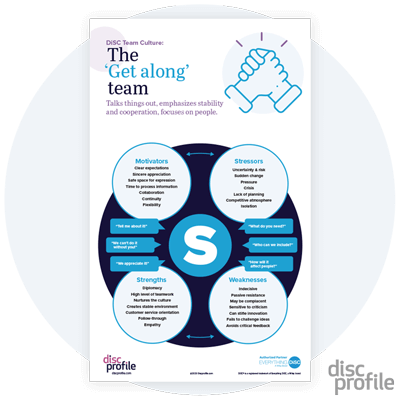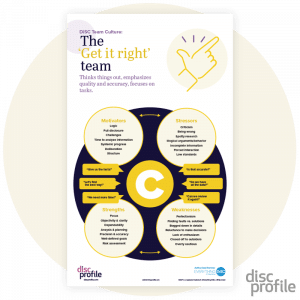DiSC Group Cultures and Styles

Just as each individual has a unique personality style, each group develops its own personality and style. DiSC® group cultures emerge from the DiSC styles of the individuals within the group. However, group culture is always more than just the sum of team members’ styles.
Key Takeaways
- Groups have personality styles, just as individuals do.
- D-style teams get results but may cultivate a stressful atmosphere.
- i-style teams are highly collaborative but may lack focus.
- S-style teams are friendly but indecisive.
- C-style teams have high standards but tend to over-analyze.
- Understanding your DiSC group style can help you produce better work and keep all team members happy and engaged.
Many factors determine group culture, such as:
- the style of the group leaders
- the most pronounced styles within the group
- the type of work the group does
- the historical culture of the group
- the cohesion or tension within the group
- the goals and mission of the group
- how long the team members have worked together
- the culture of the larger organization
Group culture is often invisible to group members—it is simply the “water they swim in.” Most people, however, feel the pressure that a culture exerts to act in a certain way, even if they aren't aware of it. Too often, team culture only becomes visible in one of these two situations:
- Something bad happens, such as a colleague quitting and citing the group's “toxic culture.”
- Someone helps the team explore their group culture constructively, such as through an Everything DiSC® session.
Group culture shapes the behavior, attitudes, and satisfaction of people in the group. People who fit into the culture often feel comfortable in the group. But for other people, the culture leads them to feel isolated or at odds with their team.
Culture also has implications for the group as a whole. It impacts how fast the team finishes tasks. It also influences how they treat outsiders. It affects their attention to detail and the risks they choose to take.
The DiSC model can help your group understand their priorities, needs, goals, fears, emotions, and behaviors within the culture.

DiSC D-style group culture: The “get it done” team
Groups with a D style focus on results and promote new ideas. However, they may face high turnover and a stressful atmosphere.
D-style groups reward:
- independence
- decisiveness
- directness
- victory
- results
D-style groups criticize:
- over-sensitivity
- hesitation
- over-analyzing
- foot-dragging
- weakness
Advantages of the D group culture:
- offers a dynamic and engaging environment
- makes decisions without wasting time
- drives toward results
- provides opportunities to prove oneself
- rewards determination and persistence
- pushes for new accomplishments
- encourages innovation
- gives straightforward feedback
Drawbacks of the D group culture:
- leads to tension and burnout
- fails to analyze options
- overwhelms those who are less aggressive
- creates power struggles that lead to poor decisions
- takes too many risks
- over-emphasizes status
- discourages teamwork in favor of competition
- provides feedback without considering feelings
Download the DiSC D-style group culture poster (PDF) to help your group build self-awareness.

DiSC i-style group culture: The “get recognition” team
Groups with an i style tend to be energetic and creative. However, they may spend too much time socializing.
i-style groups reward:
- creativity
- enthusiasm
- optimism
- collaboration
- passion
i-style groups criticize:
- rulemaking
- caution
- over-analyzing
- introversion
- insensitive comments or actions
Advantages of the i group culture:
- fosters creativity through high energy
- provides a fun and optimistic atmosphere
- encourages collective brainstorming
- promotes frequent informal communication
- excels at promoting ideas
- cultivates self-starters
- provides spontaneous recognition of good work
- offers a warm and caring environment
Drawbacks of the i group culture:
- changes direction frequently
- avoids taking care of repetitive or routine tasks
- glosses over potential risks
- holds too many meetings
- spends too much time socializing
- lacks clear guidelines
- exerts pressure to be extroverted and energized
- exhibits spotty planning
Download the DiSC i-style group culture poster (PDF) to distribute and display.

DiSC S-style group culture: The “get along” team
Groups with an S style tend to be friendly and stable. However, they may struggle to make decisions.
S-style groups reward:
- cooperation
- loyalty
- humility
- thoughtfulness
- team focus
S-style groups criticize:
- aggressiveness
- pushiness
- disruptive behavior
- people who don't conform
- sudden change
Advantages of the S group culture:
- commits to getting the job done right
- provides a relaxed atmosphere
- works toward reliable results
- promotes feelings of comfort and security
- cultivates work-life balance
- encourages a strong sense of duty
- allows a high level of teamwork
- fosters polite, tactful behavior
Drawbacks of the S group culture:
- fails to challenge ideas
- lacks a competitive edge
- avoids tough decisions to spare feelings
- inhibits change and stifles innovation
- avoids giving even constructive criticism
- struggles with being indecisive
- discourages strong individual accomplishments
- allows resentment to brew beneath the surface
Download the DiSC S-style group culture poster (PDF) to help make DiSC culture more visible.

DiSC C-style group culture: The “get it right” team
Groups with a C style value high standards and diplomacy. However, they might shy away from new ideas.
C-style groups reward:
- accuracy
- completeness
- attention to detail
- on-time performance
- being dependable
C-style groups criticize:
- mistakes
- illogical behavior
- lateness
- spotty research
- drama
Advantages of the C group culture:
- calculates risks thoroughly
- delivers exceptional quality control
- makes decisions logically
- ensures accuracy
- clarifies policies and expectations
- emphasizes reliability and precision
- respects people's rights
- provides well-defined goals
Drawbacks of the C group culture:
- over-analyzes
- misses opportunities because they are too cautious
- stifles informal communication
- fails to foster a strong sense of community
- ignores people's feelings
- feels critical, cold, or cynical to some
- closes itself off to outsiders
Download the DiSC C-style group culture poster (PDF) as a resource for your team and the people who work with your team.

Adaptive team cultures
People can use different parts of their personalities in various situations. Likewise, teams can choose to lean on their strengths and tackle their challenges. Teams aren’t constrained by their group’s culture.
If your team has many members with one DiSC style, it may rely too much on that style’s traits. This can make it hard to meet your goals. So a few people on a mostly C-style team might decide to act as more of a cheerleader for their group. An S-style team might add structure to help them maintain focus on timelines and results.
Leaders can make a note of their teams’ differing styles. They can select ways of motivating or rewarding each team based on their styles. They can possibly gain insight into conflict between two of their teams.
Everyone on a team can improve morale by recognizing members with different styles from the group’s style. For example, my CD-style colleague feels anxiety in meetings with an i-style team. She wants to get to work, be clear about guidelines, and remain introverted. However, when she is part of a team that appreciates her research and analytical abilities, she feels at ease.
In this situation, the i-style team members could call upon my colleague's flair for process and progress. This will help them balance their enthusiasm with more practical matters. And my colleague can remember the value of collaboration and novelty. She might need to do a bit more social chatting than she would in a C-style group, but that's what stretching your style is about.
DiSC group culture assessments
Everything DiSC products provide many ways to explore DiSC group culture.
Everything DiSC® Group Culture Reports help you understand the strengths and weaknesses of your group’s DiSC culture. They also show how this culture affects group members and team performance.
If your group is using the Everything DiSC® on Catalyst™ platform, you’ll be able to create your own groups. You'll see each member of your team on the group map and get insight into the group dynamics of that specific team. You can view group continua, seeing where team members fall on various behavioral scales. And Catalyst provides discussion guides for each team you create.
Do teams work best with one style or many?
We get this question a lot, but the truth is that there’s no ideal team composition, style-wise. Teams will work best when they have self-awareness and cohesive communication. A team with one person of each style and a team where everyone has the same style can be equally effective.
When your team has a lot of people with similar styles, it might be easy for them to gel. But it can also mean the group overlooks different approaches.
A group with two heavily represented styles may sometimes end up with competing priorities. This can lead to exciting and productive conflict, or to frustrating stalemates.
Groups with a mix of styles may benefit from complementary strengths. That’s especially true when people stay open to differing perspectives. Otherwise, group members may sometimes pull in different directions, with like-minded people sticking together and reinforcing blind spots.
Some groups have one or a few people whose style differs from almost everyone else. At times, they bring a fresh perspective to the group. Other times, the group fails to value their priorities.
All teams can be cohesive and high-functioning if they put in the work to build a healthy culture.
Posted 07/01/2011, Last Updated 01/18/2025






